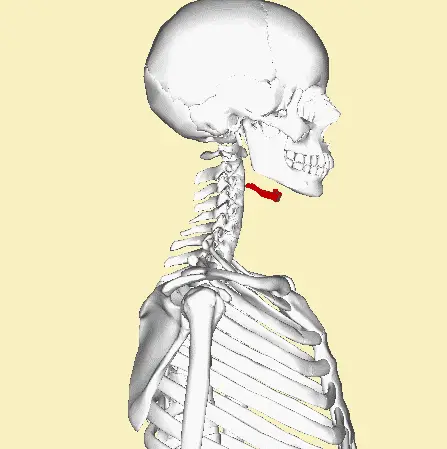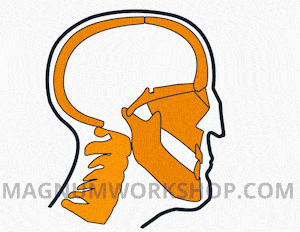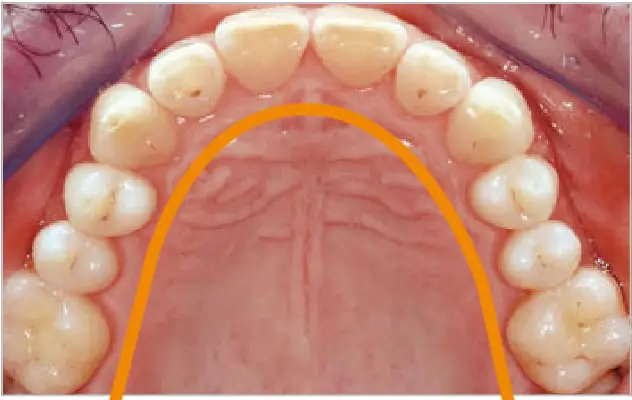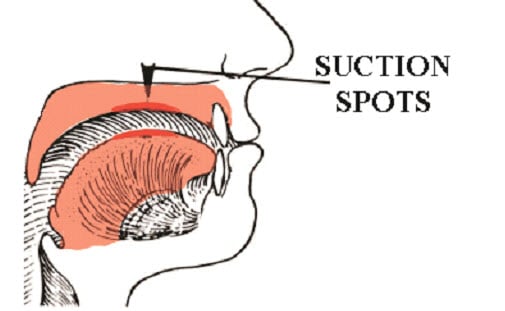
How do I even know if I’m doing mewing properly? If you’re new to mewing, you might be asking yourself this for a couple of months. Even after watching several instructional videos and reading through many articles, some people still don’t have confidence that they’re mewing correctly.
A great way to tell that you’re mewing correctly is paying attention to your hyoid and seeing if it moves up when you mew. On top of that, as long as you’re paying attention to tongue and body posture, have sealed lips, and the back of your tongue on your palate, you’re most likely mewing correctly.
Pay Attention to the Hyoid Bone

The hyoid bone is a U-shape bone at the level of the mandible. Also, the hyoid bone hangs and supports the tongue. At the same time, the tongue performs its function better because of the hyoid bone.
When you are mewing correctly, your hyoid bone also moves upward. This upward gesture is assisted by the muscles surrounding the hyoid bone. You’ll be able to see this in a profile view in the mirror, as the area under your jaw will literally move up. If you see this, you’re most likely mewing correctly.
The hyoid muscles should be tucking inwards once you engage the back third of the tongue on mewing. To have full engagement of the hyoids, imagine that you are trying to prevent a yawn.

Consistency
You need to be mewing 24/7 to achieve actual change in your facial bone structure. You also need to be mewing while you are sleeping. It sounds weird, but it can be done, and it will take time. If you don’t commit to mewing at all times, you’ll be giving up the chance to improve your appearance.
Staying consistent is probably the most challenging part of mewing, but also the most important. If you’re not consistent, that’s the first thing you need to fix. Put sticky notes around the corners of the house that you usually hang out at. You can change the wallpaper of your phone or set alarms/vibration to go off in periodic increments.
Have Even Pressure on the Maxilla
Correct tongue posture alongside the evenly-applied pressure to the roof of the mouth affects how your facial bone structure develops. Your back third should be on the roof of your mouth, but you don’t want to be pressing harder there. You want evenly-dispersed pressure everywhere.
You need to make sure that your tongue covers a significant area of your upper palate and be careful not to push forward your front teeth. Your tongue should only go as far as the incisive papilla.

Involve the Back Third of the Tongue
The back third of your tongue is the hardest part to get up while you are mewing, but it is the primary indicator of mewing correctly. If you think you can’t get the back third up the roof of your mouth, try making a big gulp or swallow while sealing your lips.
Forceful swallowing will make your back third rise and touch the soft palate. Some people suggest saying the word “sing” so you know the position of your tongue should be in. When you practice mewing for more extended periods, engaging the back third of the tongue also becomes more natural.
However, if you are recessed or have a small palate, you might not be physically able to get the back third of the tongue up, or at the very least, will have difficulty in doing so. At this point, mewing is unlikely to help you, and you need surgical/orthodontic intervention.
Lip Seal
Making sure that you seal your lips at all times also ensures that you are breathing through your nose. The biggest problem for mouthbreathers is that the longer they go with bad oral posture, the more their face elongates.
Sealing the lips is very easy to do for most people. However, for those who have lip incompetence, malocclusions, and bite problems, it will be more challenging. It’s best to treat the issue that prevents normal lip seal before ever starting with mewing. This could mean braces or full-on jaw surgery.

Teeth Lightly Touching
Although the heart of mewing lies in making sure that your tongue stays at the roof of the mouth, the teeth touching each other is the soul of it. The main reason why mewing creates facial upswing is that the teeth apply pressure to the maxilla, forcing the lower portions of the face to follow the upward and forward motion.
The most effective way to have an upswing in facial structure is by chewing hard foods. But you won’t be eating for 24 hours. By engaging in proper mewing practice, your molars will be lightly touching, therefore, offering extra support to the maxilla even though you are not chewing.
A study conducted on children with malocclusion gave the children treatment that focused on maxillary expansion. The researchers showed a significant upward and forward movement of the maxilla, thus affecting the mandible length. This study showed that even children with malocclusion would achieve great facial structure if they are given early treatment (Baccetti et al., 1998).
If you think you’re not getting any results with regular mewing, you might want to try hard mewing. Hard mewing is done when you apply as much force as you can on the roof of your mouth. Some people vouch that hard mewing can give faster results than regular mewing. A good indicator that you are hard mewing correctly is if you feel pressure on your cheekbones.
Another thing you have to keep in mind when your teeth are in contact with each other is to avoid grinding them. Too much teeth contact and excessive grinding can lead to tooth damage. If you feel pain or discomfort, stop what you’re doing, take a week off, and try again with half the force you were using.
Great Body Posture
Although the basic premise of mewing is engaging in proper tongue posture, whole body posture is almost as important. Having good posture starts with how you stand. Ensure you stand straight and tall, with your shoulders back, and your neck neutral (not forward). You should be looking down slightly and put your weight on the balls of your feet.
A great way to ensure you have proper body posture is by doing the McKenzie chin tuck.
This is the most important exercise for nerd neck and the forward head posture common in modern society. Do this exercise every chance you get.
Suction Hold
Those who are new in their mewing journey may find the concept of suction hold challenging to grasp. But basically, the suction hold is just a vacuum that you can feel between your tongue and hard palate. The idea is that your tongue should be naturally suctioned to the hard palate.
For you to do suction hold, assume the necessary process of mewing: seal your lips, tongue at the roof of the mouth, and when you feel that the spit starts to develop, gather it all in one area. Roll your spit down the tongue and esophagus and make sure you are not using any of the muscles of the cheeks and face to do so. Continue doing this until you have built up enough pressure between the tongue and hard palate.

To learn more about the suction hold, please refer to this article.
Proper Swallowing
Properly swallowing while mewing is easy. You just need to roll your food up in your tongue, and not use your cheeks to push it down the esophagus. Instead, use your tongue in a wavelike motion to move the food back. When you swallow correctly, you also apply a lot of force with the posterior third of the tongue.
To find out if you are swallowing correctly, you can try swallowing while your mouth and lips are open. I know it sounds weird, but if you can do it, it’s already a good indication that you are already a master of proper swallowing.

